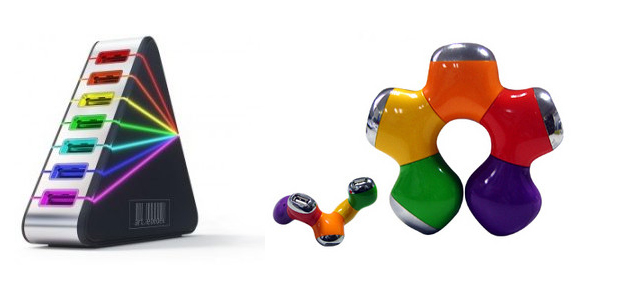The reasons why you should consider buying a USB Hub
During the past few years, USB peripheral devices have become almost omnipresent in the computing field, practically including everything: from connectable drink warmers, portable fans and shaving machines to regular external hard drives. The almost uncontrollable growth of these innovative and useful – at least in most cases – devices has filled our home and office desks and PCs with hundreds and hundreds of cords. However, there is a slight problem: there never seem to be enough available ports. In order to solve this annoying issue, manufacturers have come up with a simple solution: all you have to do is buy a convenient USB hub. This is a compact connectivity solution that will allow you to easily connect various additional devices by means of a single slot just by adding several extra ports. By using a USB Hub, you can forget about swapping out your devices each time you need a different port. Just plug in this extremely useful product and breathe a sigh of well-deserved relief. By linking USB hubs together you can build on a whole network, with dozens and dozens of ready to use ports.
Types of generic USB Hubs
Generic USB hubs are devices that split one USB port into several ports. There are 2 available types of generic USB Hubs: bus-powered and self-powered.
A bus-powered hub practically receives power from a PC or other types of self-powered hubs (e.g. a scanner or a printer). Low-powered USB devices, such as joysticks, keyboards, cameras, all-in-one units, or a mouse can be plugged into bus-powered hubs. This type of devices is generally cost effective. However, bus-powered hubs have a major drawback: they do not work with devices that need power superior to 100mA.
Self-powered hubs come with an AC adapter that ensures that the hub receives the necessary external power. For example, a PC or a scanner is a self-powered hub. In order to use such a type of hub, you need to connect the AC adapter cord to an electrical output. Usually, self-powered hubs come with 4 or 7 USB ports. Self-powered hubs can provide up to 500mA of power.
However, keep present that, according to each type of device, a different level of power might be necessary. In order to know how much power a specific USB device needs, you must open the listing of the hub you have connected your device to and check the Power Tab. If a device needs more than 100mA of power, it can’t be plugged into a bus-powered hub.
Keep in mind that it is not advisable to connect 2 bus-powered hubs together, mainly because there will not be sufficient power for both hugs and the devices that you attach to them. Instead, for a better performance, use a self-powered hub and a bus-powered one. If you wish to connect more than 3 hubs, make sure that the chain alternates.
USB Hubs: What you should look for in a good one
Though USB Hubs are basic devices, with limited features and simple instructions, there are a few important aspects that put a special emphasis on good quality ones. Apart from the cost of such a device, it is important to take into consideration the features of the product itself, its overall durability, or the quality of the customer service that backs up the respective device. But let’s have a look at each one of these categories:
- Hub features: one of the main features to consider when buying a USB hub is how many extra ports it can add. Make sure you choose the one that best adapts to your real needs. It is also advisable to check if the device comes with a cable you can attach to your PC or if you have to purchase your own. In addition, you should also check if the device includes a power adapter for those types of connections that need a greater power output. If you wish to connect input devices – such as game controllers, a mouse, or a keyboard -, you can choose a USB 1.1 bus-powered hub (also commonly known as a simple USB Hub). Nevertheless, the USB 2.0 types, also known as High Speed USBs, are much more versatile and they are able to provide sufficient power for almost any type of USB device.
- The overall durability: if you purchase a USB Hub that is able to add several ports but fails when it comes to handling the extra load is not of much use. So maybe gathering some previous information from users reviews about their durability and performance might not be a bad idea. Check the sturdiness of its construction. Some devices overheat extremely easily and can break without undergoing a real pressure.
- Help & Support: there are available products that offer lifetime warranties. This means that the device is practically guaranteed against failure for as long as you use it. Other types of devices offer more time limited warranties that can range from on year to several ones. Apart from the product’s warranty, you should also check if there is an available telephone line, live chat options, and e-mail support. A quality Help & Support service means that there will always be someone available to answer your questions and help you deal with any type of problem.
So, if you are looking for a valid solution to clean the cords clutter on your desk, you should consider buying a USB Hub. There is a wide variety available on the market you can choose from. Cables To Go, Tripp Lite, Belkin, or iHome are only a few of the best available ones.

